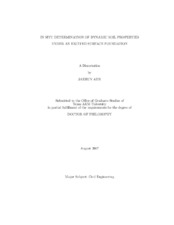| dc.contributor.advisor | Biscontin, Giovanna | |
| dc.creator | Ahn, Jaehun | |
| dc.date.accessioned | 2010-01-14T23:58:02Z | |
| dc.date.accessioned | 2010-01-16T01:48:07Z | |
| dc.date.available | 2010-01-14T23:58:02Z | |
| dc.date.available | 2010-01-16T01:48:07Z | |
| dc.date.created | 2007-08 | |
| dc.date.issued | 2009-05-15 | |
| dc.identifier.uri | https://hdl.handle.net/1969.1/ETD-TAMU-1460 | |
| dc.description.abstract | The dynamic properties of soil are normally inferred from laboratory tests on
collected samples or from empirical relations. The soil properties measured in the field
can be very different from those predicted from laboratory tests. It is very difficult
to determine directly in the field the variation of the shear modulus and damping
with the level of excitation (level of strains). This remains today a major gap in our
knowledge and our ability to conduct reliable seismic analyses.
The main objective of this study is to assess the feasibility of determining reliably
in situ the shear modulus and damping of the soil as functions of the level of
strains, developing a method to compute these properties from the measured data
and providing practical recommendations for the use of the procedure. To achieve
this objective, extensive and comprehensive sets of experimental and analytical studies
were conducted in parallel. Some numerical analyses were performed to provide a
better understanding for performing in situ tests with the newly developed vibroseis
loading systems. In addition, the dynamic response of a surface foundation in vertical
vibration were studied. This dissertation mostly focuses on the numerical aspects of
the problem while some experimental data are also studied and utilized.
Field tests were conducted to estimate shear moduli of silty sands at two sites, the
Capital Aggregate Quarry and the Texas A&M University sites. Estimated nonlinear
shear moduli presented very consistent trends regardless of the analysis methods and test sites. They showed larger elastic threshold shear strains, 1.5 × 10−3 % for the
Capital Aggregate Quarry site and 2 × 10−3 % for the Texas A&M University site,
than the mean of shear modulus curve for cohesionless soils proposed by Seed and
Idriss (1970). Estimated moduli closely followed the mean of Seed and Idriss (1970)
at strains larger than 6 × 10−3 % for both sites. Internal damping ratio can also be
estimated if additional data are gathered from in situ tests in the future. | en |
| dc.format.medium | electronic | en |
| dc.format.mimetype | application/pdf | |
| dc.language.iso | en_US | |
| dc.subject | soil modulus | en |
| dc.subject | soil damping ratio | en |
| dc.subject | dynamic soil properties | en |
| dc.subject | in situ test | en |
| dc.subject | surface foundation | en |
| dc.subject | inverse analysis | en |
| dc.title | In situ determination of dynamic soil properties under an excited surface foundation | en |
| dc.type | Book | en |
| dc.type | Thesis | en |
| thesis.degree.department | Civil Engineering | en |
| thesis.degree.discipline | Civil Engineering | en |
| thesis.degree.grantor | Texas A&M University | en |
| thesis.degree.name | Doctor of Philosophy | en |
| thesis.degree.level | Doctoral | en |
| dc.contributor.committeeMember | Barroso, Luciana | |
| dc.contributor.committeeMember | Kundur, Deepa | |
| dc.contributor.committeeMember | Roesset, Jose M. | |
| dc.type.genre | Electronic Dissertation | en |
| dc.type.material | text | en |
| dc.format.digitalOrigin | born digital | en |


